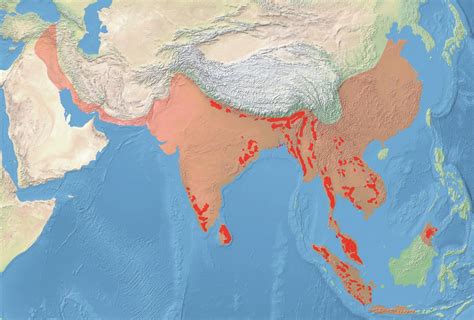asian elephant historic range|map of asian elephant habitat : 2024-10-04 In general, the Asian elephant is smaller than the African bush elephant and has the highest body point on the head. The back is convex or level. The ears are small with dorsal borders folded laterally. It has up to 20 pairs of ribs and 34 caudal vertebrae. . See more
The Omega Seamaster “Anakin Skywalker” ref. 145.023 is the perfect watch to close out this list of the most remarkable Omega watches from the 1970s. As Lex perfectly explained in his article about the watch from .
0 · why are asian elephants endangered
1 · where are asian elephants located
2 · where are asian elephants found
3 · map of asian elephant habitat
4 · asian elephants in danger
5 · asian elephant range map
6 · asian elephant map
7 · are asian elephants dangerous
$12K+
asian elephant historic range*******The Asian elephant (Elephas maximus), also known as the Asiatic elephant, is a species of elephant distributed throughout the Indian subcontinent and Southeast Asia, from India in the west to Borneo in the east, and Nepal in the north to Sumatra in the south. Three subspecies are recognised—E. m. maximus, . See more
Carl Linnaeus proposed the scientific name Elephas maximus in 1758 for an elephant from Ceylon. Elephas indicus was proposed by Georges Cuvier in 1798, who described an . See moreAsian elephants are distributed throughout the Indian subcontinent and Southeast Asia, from India in the west, to Borneo in the east, and See moreAsian elephants are crepuscular. They are classified as megaherbivores and consume up to 150 kg (330 lb) of plant matter per day. . See more
The Asian elephant is listed on CITES Appendix I. It is a quintessential flagship species, deployed to catalyze a range of conservation goals, including habitat conservation at . See more
In general, the Asian elephant is smaller than the African bush elephant and has the highest body point on the head. The back is convex or level. The ears are small with dorsal borders folded laterally. It has up to 20 pairs of ribs and 34 caudal vertebrae. . See more
The pre-eminent threats to the Asian elephant today are the loss, degradation and fragmentation of its habitat, which leads to increasing conflicts between humans and . See moreAbout half of the global zoo elephant population is kept in European zoos, where they have less than half (18.9 years) the median . See more Now an endangered species, Asian elephants hang on in only about 5 percent of their historical range. There may be fewer than 50,000 in the wild, with about . The map below shows the modern (red) and historical (pink) ranges of the Asian elephant. Elephant populations have decreased by 62% over the last decade. The main historical factors behind elephants' .Across much of their remaining range, however, the reality is very different – Asian elephants are now restricted to just 10% of their historical range. They are in urgent .map of asian elephant habitatThe Asian elephant is the largest land mammal on the Asian continent. They inhabit dry to wet forest and grassland habitats in 13 range countries spanning South and Southeast .
We model historic range in suitable habitat over the past 1165 years for a widely-distributed endangered mammal, the Asian elephant (Elephas maximus). .As a result, Asian elephants now occur on only about 10% of their historical range and many of the remaining populations are both small and isolated. Our Goal. A world where people and ecologically functioning .
Our current focus is on historical populations of Asian elephants that lived in the Near East, far to the west of the species’ current range in the Indian subcontinent and south .
More than 3 million square kilometers of the Asian elephant's historic habitat range has been lost in just three centuries, a new report from an international scientific team led by a.A large portion of the world’s human population now lives in or near Asian elephant habitat, which has dwindled to just 15% of its historic range. Habitat loss and fragmentation and pressures from poaching and the .
Now an endangered species, Asian elephants hang on in only about 5 percent of their historical range. There may be fewer than 50,000 in the wild, with about 30,000 in India and 6,000 in Sri Lanka .
The Asian elephant is the largest living land animal in Asia. Since 1986, the Asian elephant has been listed as Endangered on the IUCN Red List, as the population has declined by at least 50 percent over the last three .As a result, Asian elephants now occur on only about 10% of their historical range and many of the remaining populations are both small and isolated. Our Goal. A world where people and ecologically functioning .asian elephant historic range map of asian elephant habitatThe Asian elephant is the largest land mammal on the Asian continent. They inhabit dry to wet forest and grassland habitats in 13 range countries spanning South and Southeast Asia. While they have preferred forage plants, Asian elephants have adapted to surviving on resources that vary based on the area. Asian elephants are extremely sociable . The extant Asian elephant range (Fig. 1) is thought to represent only a subset of the species’ historic range 20, with the far western population thought to have gone extinct by 100 BCE and most .
The Asian elephant (Elephas maximus L.) is native to mainland Asia.Its distribution ranges in India, Nepal, Bangladesh, Bhutan, Myanmar, Thailand, Malay Peninsula, Laos, China, Cambodia, and Vietnam (Sukumar 1993).Asian elephant’s population has declined from an estimated 100,000 elephants on the turn of the twentieth century to an estimated .

Elephants are the largest terrestrial mammals. An Asian elephant bull can attain a height of 11 feet and a weight of over six tonnes. Record tusks have measured over 8ft (240cm) in length, but on average, they are between 3 and 6ft (91 to 182cm) long. Females and some males (called makhnas) do not have tusks but have small tusk-like teeth .Asian elephants once ranged from Western to East Asia and south to Sumatra. and Java. It is now extinct in these areas, and the current range of Asian elephants is highly fragmented. The total population of Asian elephants is estimated to be around 40,000–50,000, although this may be a loose estimate.
Priority should be given to ensure larger areas by securing the identified elephant corridors. The Asian Elephant Specialist Group, an initiative of the World Conservation Union, attempts to assist in scientific management of elephants in the range countries by providing expertise and organising financial support wherever necessary. Asian elephants started to recolonize their northern historical range in 1995, likely with an increase in population size (Liu et al., 2017; Huang C. et al., 2020). Human-elephant conflicts have been increasing due to their population expansion as well as land-use expansion by people during the past half-century in Yunnan Province ( Xu et .

More than 3 million square kilometers of the Asian elephant's historic habitat range has been lost in just three centuries, a new report from an international scientific team led by a University .asian elephant historic range More than 3 million square kilometers of the Asian elephant's historic habitat range has been lost in just three centuries, a new report from an international scientific team led by a University . Asian elephants are confined to 5% of the historic elephant range 24. Elephants use large areas to meet their dietary and reproductive requirements 25, 26. Their home range size varies .
Asian elephant guide: where they're found, how long they live, and how .
“Asian elephants’ range states have a lot of issues in common, . researchers estimate that the species’ habitat has dwindled to just 15 percent of its historic range. CSS Asian Elephant is set to become a beacon of hope for the conservation of this iconic species and a model for collaborative species survival initiatives .
Global space for Asian elephant habitats has been in rapid decline since the 1700s, a new report reveals. More than 3 million square kilometers of the Asian elephant's historic habitat range has .
The historic and current (extant) wild Asian elephant population in the 13 range states: Bangladesh, Bhutan, Cambodia, China, India, Indonesia, Laos, Malaysia, Myanmar, Nepal, Sri Lanka, Thailand, and Vietnam. Image courtesy of IUCN Red List. As a growing network of 25+ members, the Asian Elephant Transport Working Group provides solutions for .
Fewer than 1,000 individuals in half of the range countries where Asian elephants occur. Small (fewer than 500 individuals), highly threatened populations in Vietnam, Bangladesh, China, Nepal, . Presently occupy only 15% of their historic range; much habitat converted to agriculture;The Asian elephant has three recognized subspecies based primarily on body size and slight differences in coloration, including (1) Elephas maximus maximus (Asian elephant, Linnaeus, 1758) from .
This watch is an Oyster Perpetual ref. 1002 with a serial number dating back to 1966. Inside it beats a Rolex 1560 caliber, an automatic movement with an .
asian elephant historic range|map of asian elephant habitat











